 | E-mail to Birds Korea |
 | KWBS |
in the Region
 | The Oriental Bird Club |
 | BirdLife International (Asia) |
December
Periods of intense cold alternate with milder spells. In the coldest winters maxima are often below freezing; in milder winters maxima often reach 10°C in Seoul. A few lingering autumn migrants can still sometimes be found as well as huge numbers of wintering waterbirds.
A great birding month. Saunders’s Gulls are widespread, while very small numbers of Relict Gulls also start to appear at a number of sites, especially in cold winters. Scaly-sided Merganser are back on preferred rives (with at least 140 overwintering in 2012), while numbers of Baikal Teal usually also reach their peak. Tundra Bean Geese are widespread in rice-field areas, and Taiga Beans too can be found in the low thousands especially in the southeast, the mildest part of the mainland. Raptors include good numbers of Cinereous Vulture in the Cheorwon Basin, where they are often joined by White-tailed and the occasional Steller’s Sea Eagle, while cranes (Red-crowned, Hooded, and White-naped), also remain at key sites. Numbers of wintering landbirds vary in number greatly from year to year. Most years, there are large numbers of Brambling and Rustic Bunting (especially towards the north), mixed thrush flocks (including Naumann’s and Dusky Thrushes and the occasional Red-throated Thrush) and occasionally large numbers of Siberian Accentor. Towards the south, species such as White’s and Pale Thrush, Japanese Bush Warbler, Red-flanked Bluetail and Japanese White-eye also remain in reasonable numbers - on Jeju Island and in the far southeast.
Highlights in recent years have included irruptions of Chinese Nuthatch (especially in 2012 / 2013), and multiple records of Sandhill Crane, Siberian Crane and Cackling Goose. National firsts in the past ten years or so have included Grass Owl (2003), Meadow Pipit (2006), and Lesser Black-backed Gull (2008).
Southeast, December 29-30
The last few days have made for some very exciting birding here in the Southeast. On Monday the 29th, I returned to Hwapo Cheon and spent most of the day quietly watching and working through a very large flock of geese (containing between 3,400 and 3,700 birds, with the vast majority Taiga Bean and Greater White-fronted Goose, with perhaps 10-20 Tundra Bean Goose also mixed in, along with several Korean Water Deer!). Many of these geese showed quite a bit of variation (size, structure and plumage), especially the Greater White-fronted Geese. Finding a Lesser required more than searching out a cute, golden eye-ringed grey goose because many of the GWF also share these features. The combination of these characteristics with the Lesser’s unique bill shape, size, and color were an easier way to distinguish between the two species. I took quite a few images that will be included in a later follow-up blog post.


On Tuesday the 30th, I was joined by Dr. Nial Moores [NM]. We started off the morning in some “relict wetland” near to the main barrage, and then looking at gulls and other birds in the Nakdong Estuary. We then went on to Hwapo and finished at Junam. The total number of species for the day was 96. Here are some of the highlights from the 30th, in order of observation (with all of NM’s images below taken with a hand-held compact digital camera through a really superb Swarovski scope):


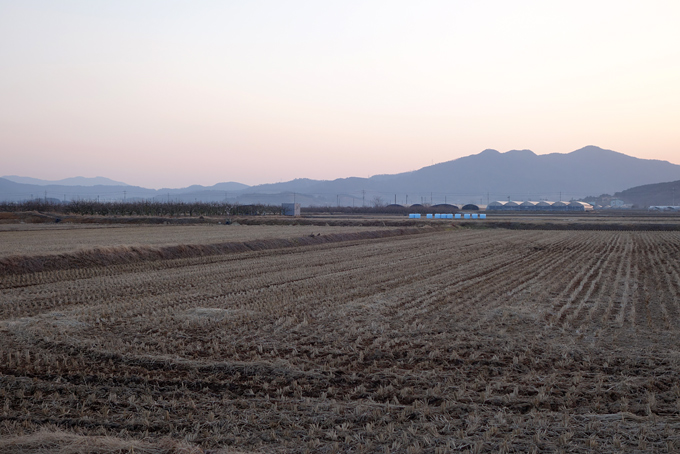

- Dusky Thrush. A dozen or more were seen at the Nakdong River with several also at Junam, where there was also a Naumann’s Thrush.
- Common Snipe. One was seen in flight along the Nakdong River and six were seen feeding and roosting on a muddy bank across from Eurasian Spoonbills at Junam Reservoir.
- Relict Gull. On the way to one of our usual viewing points over the Nakdong Estuary, NM casually said from our moving car, “Oh look, a Relict Gull,” and indeed just across the river on some exposed tidal flat, there was a stunning Relict Gull at relatively close range. We saw six there, including five First-winters and one Second-winter.
- Stellers’s Sea Eagle. There was a very handsome sub-adult Steller’s out in the estuary. At one point, this Steller’s and a nearby Relict Gull (along with several Saunders’s Gull) could be seen together in the same scope view – how often does that happen? We also observed two White-tailed Eagle along the river on our way to the estuary.
- Eastern Marsh Harrier. At the Nakdong Estuary, an immature male and an immature female were seen in flight, with the male also seen sitting on the bank near some reeds.
- Tundra Swan. Two adults with one juvenile were also observed at the estuary.
- Lesser White-fronted Goose. Four were at Hwapo on the 29th with two there still on the 30th.
- Taiga Bean Goose. NM found a very distinctive bird that I might also have seen on the 29th and will post images of later. In striking contrast to the more “typical” big-end middendorffii, this Taiga Bean had a strikingly thin, long-looking bill and looked much smaller-headed and flatter-headed than the "typical" middendorffii near to it, recalling (for NM at least) more western populations. Notably, it also was much paler-necked and perhaps also had paler fringes to the upperparts than most of the other Taiga Beans.
- Cinereous Vulture. On both days at Hwapo, 100+ were seen mostly in flight, although many of them were also sharing the same habitat as the large flock of geese. At times, some of the vultures would swoop down closely over the geese bringing large numbers of them up in the air, only to circle around and resettle on a different part of the grassy field.
- White Wagtail. There was at least one leucopsis White Wagtail at Hwapo and two or more at Junam. Lugens is the common White Wagtail in winter. Leucopsis is still scarce in winter, though perhaps increasingly-reported.
- White-naped Crane. On the 30th, 204 were counted, which, along with two Hooded Crane, were feeding and roosting in Junam Reservoir. This was the first time this year to see such a high number together here.
- Swan Goose. One on Junam Reservoir.
- Great Cormorant. At least 1,100 cormorants were roosting in the trees in Junam Reservoir, with many birds usually present during the day and highest numbers toward the evening.
- Japanese Quail. Three were heard vocalizing after sunset at Junam Reservoir, as we enjoyed an unforgettable winter wetland soundscape.
- Short-eared Owl. Although it’s very hard to beat a Steller’s or a Relict, personally this lone owl was the Bird of the Day. After many years of wanting to find this species in Korea, here it was, sat quietly on a bund in the middle of some rice fields a short distance from one of the Junam farm roads near a persimmon orchard. The sun was setting, as NM and I stood and watched this stunning owl, as it also appeared to be watching and listening to us. As the sun went down, the bird flew and perched in one of the nearby persimmon trees. For me, this was the perfect ending to a very good year.
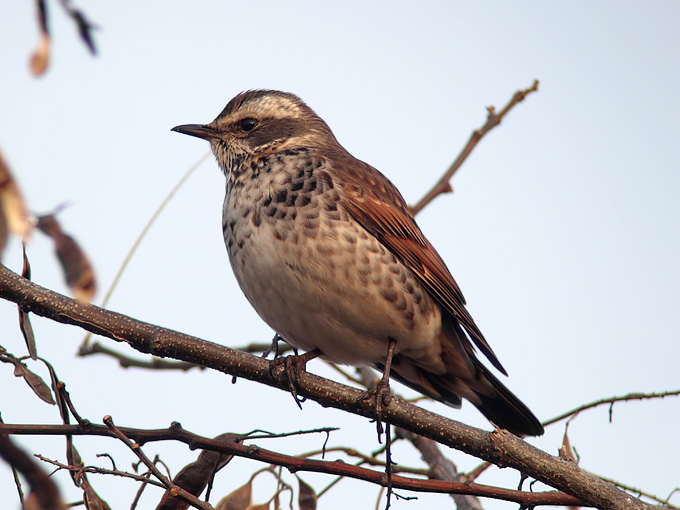


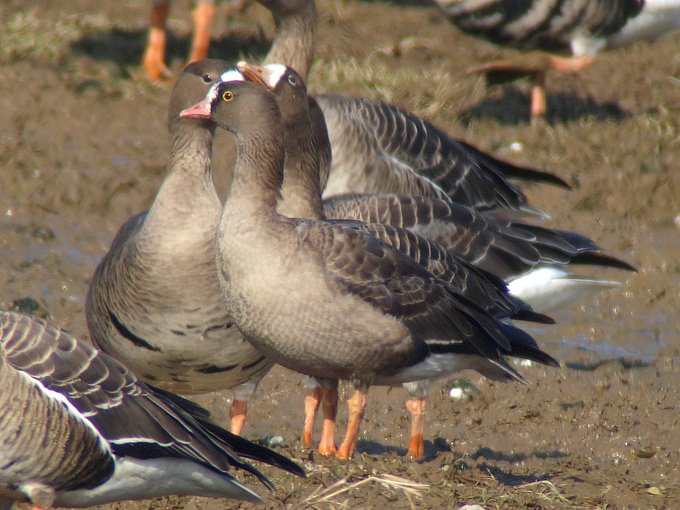


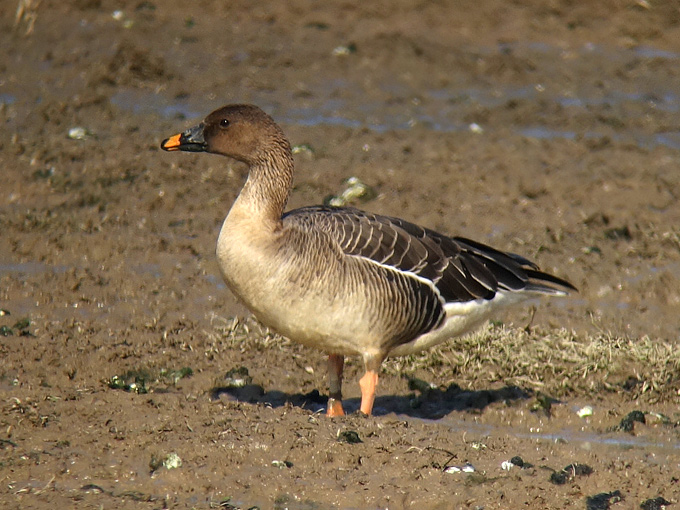

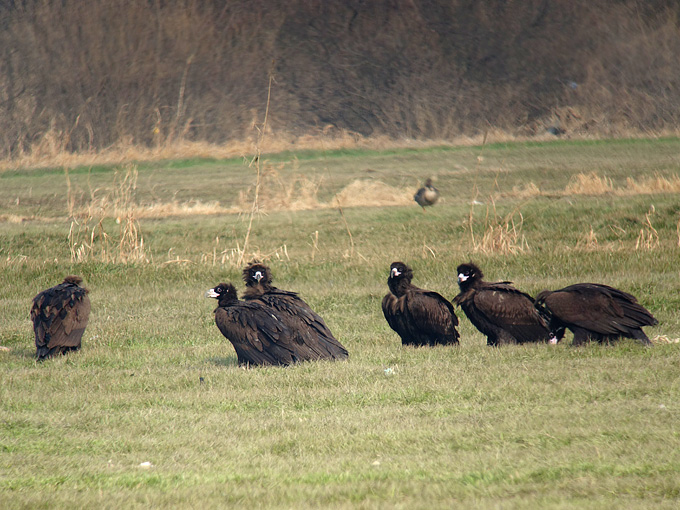
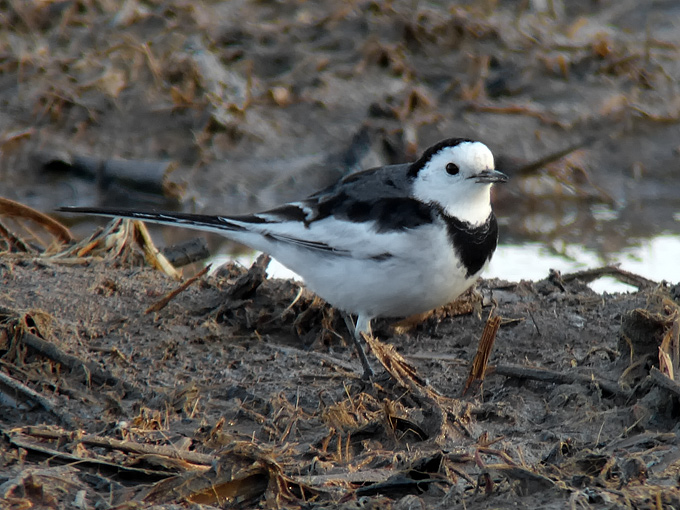


Gangneung, December 29
Bird News from Tim Edelsten
Most noteworthy offshore were 1600+ Great Crested Grebe idling in the bay, where also e.g. a close pair of Horned Grebe, a Harlequin, a Black-necked Grebe, four Ancient Murrelet and a Goldeneye. Unfortunately the murrelets spent much time diving around driftnets, obviously attracted to the catch in them - but unable to sense the danger.
Near the mouth of the Namdae Stream, best was a hovering Rough-legged Buzzard, several Saunders's Gull, a circling White-tailed Eagle and five Northern Lapwing. Also present e.g. two Sanderling, a Long-billed Plover, about 15 Gadwall, 15 Common Merganser and 20 Eurasian Wigeon amongst other common species.



Hwapo Cheon, December 28
Had an excellent afternoon of birding at Hwapo Cheon. My target for the afternoon was to find another large flock of vultures. Conditions were dreary but it felt like that kind of day when a birder could find something interesting. Luckily, there was very little wind. Upon arriving at the park, I realized quickly that it was a weekend (lots of noise!) and that the large vulture flock was missing. Still, there were about 40+ Cinereous Vultures, but mostly in flight with only a few on the rice fields near the main area of the park. There simply seemed to be too much disturbance. Regardless, I was able to find one tagged vulture in close proximity (tag labeled J6). About three Korean Magpies were on the field beside this vulture. They appeared quite rambunctious and seemed to be bullying the poor giant, at times pouncing on its back. Still, the vulture didn't seemed bothered and remained near the roadside for the rest of the afternoon. Leaving the vultures I decided to get a closer look at the wetland. Most of the main stream was also disturbed, but after a short search around the park, I found a quiet spot that was full of birds. Here are the highlights:
- 6 - 10 Brambling and 12+ Dusky Thrush observed perched in the trees surrounding the park.
- 3000 + Mixed flock of Taiga Bean Goose, Greater White-fronted Goose with a few Tundra Bean Goose This large flock was first seen after it was flushed away from the main park. I later relocated it at a quiet, much less disturbed patch of wet, grassy habitat.
- 3 Lesser White-fronted Goose Scanning through the previously mentioned large flock, I found two separate Lesser, which immediately brought a big smile to my face. This smile then grew bigger and became permanent for the remainder of the evening as a third Lesser came running towards my viewing point. Although the evening light was fading quickly, I still managed to enjoy superb views of this gorgeous species.
- 5 Korean Water Deer This species can be regularly observed at Hwapo, however I have never seen them in the open like this before, nor have I ever seen them interact so closely with such a large flock of geese. The geese did not appear bothered, which made for quite a beautiful setting; four water deer playing and feeding across a large patch of green habitat with hundreds of geese.
- 1 Eurasian Eagle Owl was heard vocalizing from a nearby hill at dusk while I was watching the geese, as well as a Siberian Accentor calling in the bushes behind me.
- 1 Common Shelduck One was found alongside 100 + Buff-bellied Pipit and 2 leucopsis White Wagtail feeding on a muddy, wet patch of grass near the goose flock.
- 40+ Skylark A flock was observed on and off the rice field near the tagged vulture, but I was only able to get a view of one Far Eastern Skylark before the flock moved to a further patch of rice field
- 3 Species of Woodpecker: Grey headed Woodpecker (2), White-backed Woodpecker (2), and Japanese Pygmy Woodpecker (1)
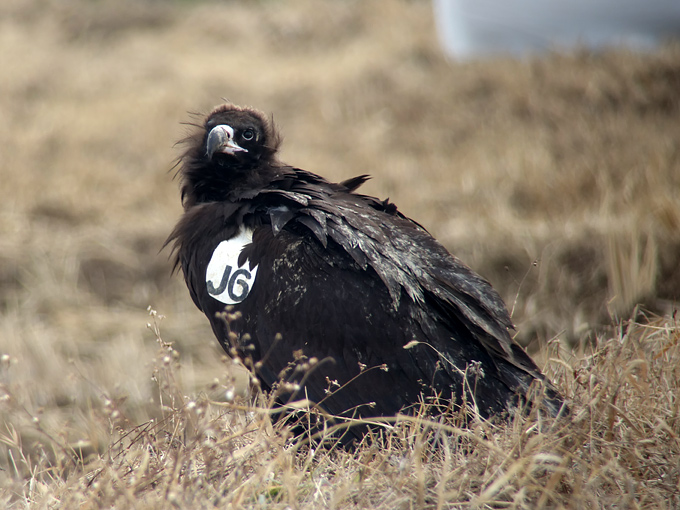

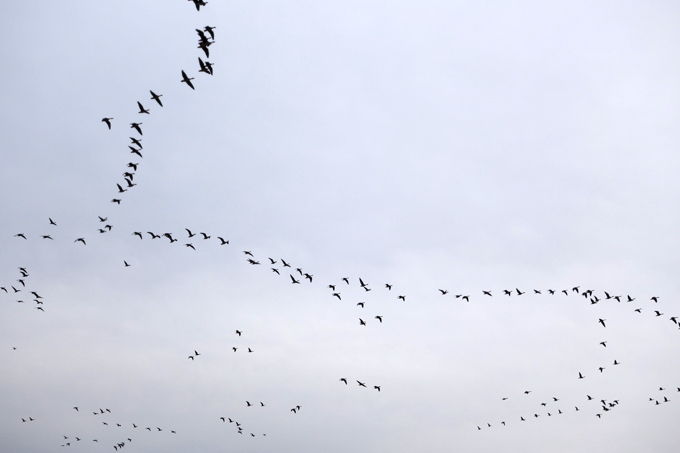
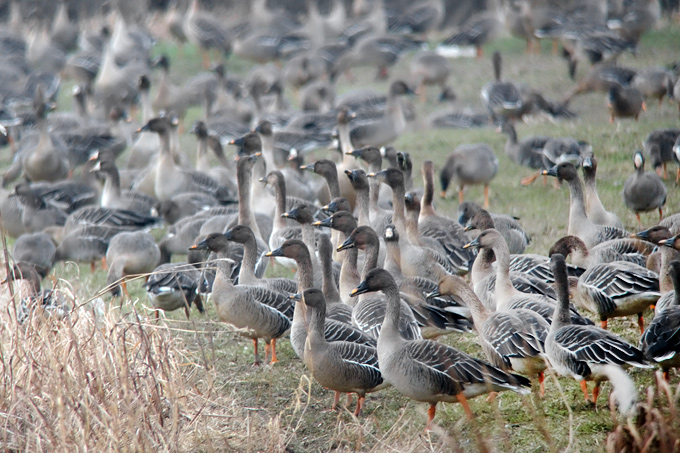
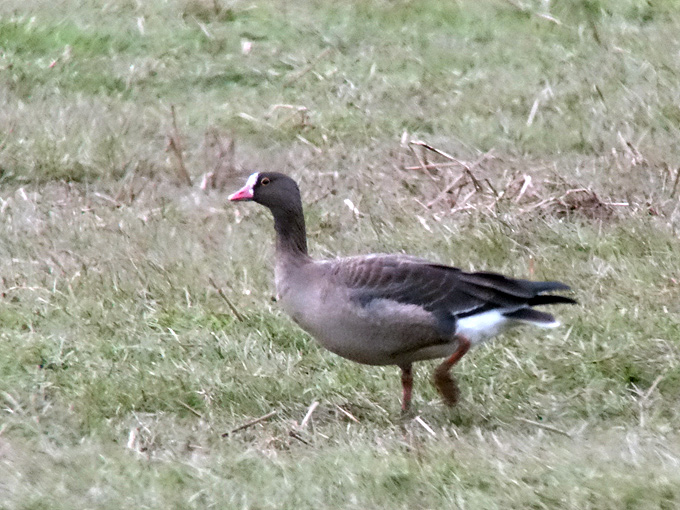
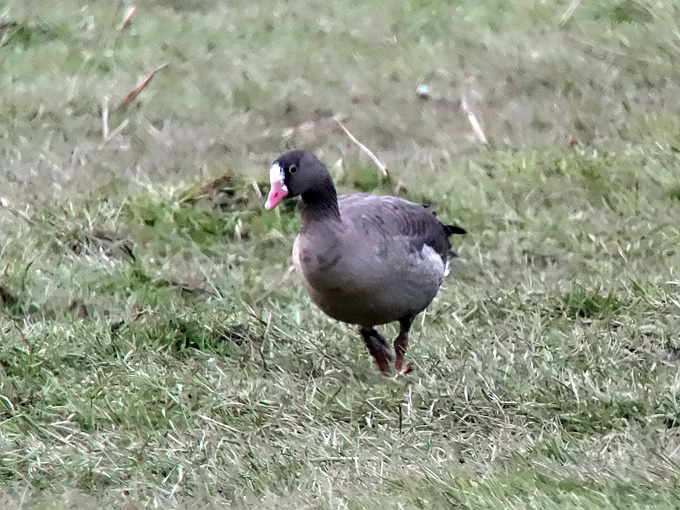
Deokjeok Island, December 27
A few hours on this island walking along the forested hillside, some farmlands and the MTB course. The hiking trails were completely free of the usual hiking crowd that descends on the island during other times of the year on the weekends. Though birds were few, some interesting species were noted.
- Siberian Accentor – Total of 7 (or 8) birds encountered in 3 different spots.
- Eastern Great Tit – The most common bird during the trip. Conservative estimate of about 120 birds in different flocks. The largest flock consisted of about 30 birds.
- Eurasian Bullfinch – 4 very approachable birds encountered along the MTB course.
- Brambling – The only other finch species encountered. Just a single individual near the start of the trail.
- Ring-necked Pheasant – About 20 encountered during the trip, including 2 males squabbling on a tree top!
- Japanese Waxwing – A single bird feeding on ripe persimmon.
- Hoopoe – One on the edge of the beach just behind the school campus.
- Naumann’s Thrush – The most common thrush species. Very vocal and actively defending the fruiting trees from the Brown-eared Bulbuls.
- Red-throated Thrush – A probably individual was seen in a mixed group of thrushes. Initially watched through binoculars at a distance towards the end of the day, only a front view was available. But the clear boundary between the red and the white on the breast, stronger coloration of the bill and some other features indicate a possible Red-throated Thrush. However, lack of clear views of the flank and undertail coverts prevent a definitive ID (Thanks to Dr Moores for his suggestions on the ID). Expert opinion based on a rather poor image below is welcome.



Junam Reservoir, December 24
On Christmas Eve, a few colleagues and I decided to choose a site and have a bird race, or a “Big Day”. I chose the Junam area including the two nearby reservoirs. The weather was pleasant with little wind and clear skies for most of the day. The water level at the main lake has finally receded, providing a mud bank for many of the wintering species to roost or feed upon, particularly for the cranes. In total I observed 65 species for the day. There were a few of the more common species, such as grebes and a few of the forest species, that I couldn’t find. There were also a few species that I was surprised to see.

Here are a few of the highlights:
- White-naped Crane Grus vipio Most of the White-napes were observed in small flocks on the rice fields throughout the morning until a large flock of 72 flew overhead, which included the two Hooded Crane mentioned in my previous Junam report. At one of the rice fields, I met a researcher studying cranes. He noted that there were close to about 220 White-napes in total. I counted 182 for the day, with many roosting at sunset on the mud spit alongside the two Hooded.
* Taxonomic side-note/inquiry: I’m aware that many taxonomic changes have been made to the BirdLife Checklist. Does anyone have information as to why the genus name for White-naped Crane has moved from Grus to Antigone (del Hoyo and Collar 2014)? Currently Sarus, Sandhill and Brolga have been also placed in the genus Antigone. The only information I can find on the web about Antigone is: “The genus Antigone differs from Grus in having nearly the whole head and neck bare; the hind-neck, face and chin covered with coarse granulations”, which was taken from an Indian Avian Biodiversity website. I also found this, via Wikipedia: “In 1976, it was suggested that the Brolga, Sarus crane (Grus antigone) and White-naped crane (Grus vipio) formed a natural group on the basis of similarities in their calls. This was further confirmed by molecular studies of their DNA. These also showed that the Brolga is more closely related to the White-naped crane than it is to the morphologically more similar Sarus Crane.” Interesting. Any thoughts?
- Greater White-fronted Goose Anser albifrons A flock of about 580 mixed with a few Bean were seen on a rice field some distance away from the main lake. There were also several hundred on the rice fields near the main lake, as well as many seen in flight. Unfortunately, I couldn’t find a Lesser.
- Swan Goose Anser cygnoides There were two on the mud spit of the main lake at sunset. They were the last new species I was able to count, and surprisingly a Peregrine Falcon (one for the day) was perched upon a tree only feet away from these two geese.
- Baikal Teal Anas formosa It’s very easy to call this the Bird of the Day after having remarkably daycent views of this beautiful species on the pond across from the main lake, and a total of 41 for the day.
- Eurasian Spoonbill Platalea leucorodia 29 were observed at roost in the early morning on the main lake.
- Rook Corvus frugilegus Up to 4 were observed throughout the day. Two of these were seen in flight, and then at mid-day, two more were seen together on a rice field. It’s very hard to know whether or not they are the same as previously seen. Personally, this is the first time I have seen this species at Junam. Lately, in the past few weeks, I have also seen small groups in and around the Gimhae area.
- Eurasian Skylark Alauda arvensis Only two were observed after an hour of watching several flocks in and out of the rice fields near the main lake.
- Far Eastern Skylark Alauda japonica Several flocks of skylark were observed, some with more than 50 birds to a flock. After spending time watching them in flight and feeding on the rice fields, I could see that most were Far Eastern. It was satisfying to finally start to get “the feel” for how to distinguish these species. For information about Skylark identification, please see our ID Notes page: http://www.birdskorea.org/Birds/Identification/ID_Notes/BK-ID-Lark-Taxonomy.shtml
- White-tailed Eagle Haliaeetus albicilla Two were seen perched on the trees next to the main lake in the early morning.
- White-cheeked Starling Spodiopsar cineraceus More than 100 observed in and around the rice fields, including one of the same hybrids observed on the 29th of November.
- Common Starling Sturnus vulgaris 16 observed throughout the day mixed with a flock of White-cheeked, with the largest concentration of starlings feeding near a persimmon orchard.
- Naumann’s Thrush Turdus naumanni 2 observed, one at Dongpan and the other at the smaller lake of the three. After looking at some of the older “classic” ID pages on the BK website, I came across this interesting one, something to keep the eyes peeled for : http://www.birdskorea.org/Birds/Identification/ID_Notes/BK-ID-Thrush.shtml
- Dusky Thrush Turdus eunomus For some reason, this species is one that I look forward to seeing wherever I’m birding. 1 was heard in the early morning, then a few others were observed perched in trees throughout the day.
- Hoopoe Upupa epops Very pleased to have found a total of 4, with the first observed in flight, another at Dongpan, and 2 together near a persimmon orchard.
- Rustic Bunting Emberiza rustica While watching the starlings feed at one of the persimmon orchards, a flock of about 30+ Rustic Buntings dropped in a perched upon the trees I watching. Interestingly, there is a record of a Rustic that ended up at Golden Gate Park, San Francisco in early December this year.
Cheorwon, December 25
Outstanding highlight was a Demoiselle Crane in the main flock of White-naped Crane, seen and off in Cheorwon since its discovery there first on November 8th by local birder Lee Sun-Woo. The bird is usually within the CCZ. The bands on this bird appear to be too abraded to read: has anyone any information of where this bird might have been banded please?

Gangneung, December 22
An early morning dash over cold and snowy mountains to the coast: our target was ducks, especially Smews, and the Guryeongpo Lake and Namdaecheon did not disappoint. Here are the highlights: c. 55 Smews, 50 Common Goldeneyes, 30 Mallards, a dozen Common Pochards, and a few Tufted and Spot-billed Ducks. We saw a few each of Pintail, Common Teal and Greater Scaup. About 12 Eurasian Coots worked the shallows. Scattered Common Mergansers — several at Namdaecheon got into a thrashing scrum when one caught a fish. Five White-tailed Eagles soared well over the ocean at Guryeongpo and another perched a Namdaecheon. Also at the stream: several Saunder’s and Black-headed Gulls, a pair of Lapwings, a calling Chinese Penduline Tit, a Peregrine, a Kestrel, and a Common Snipe.
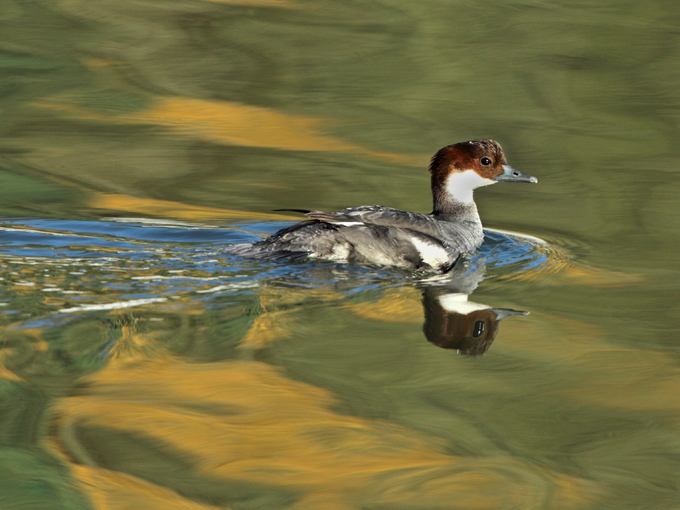
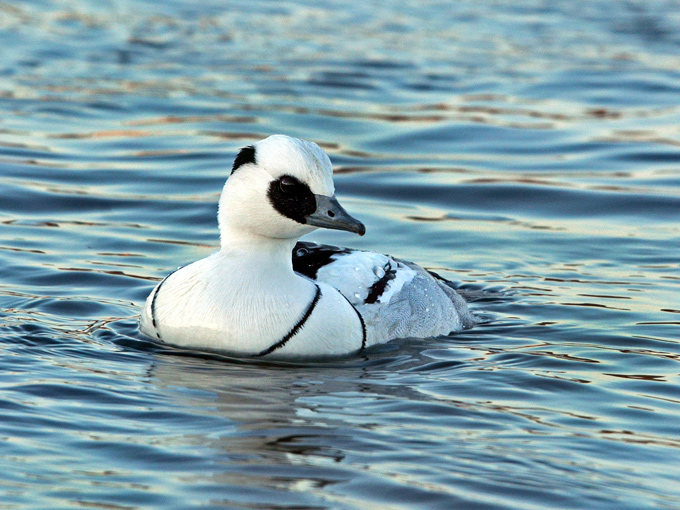






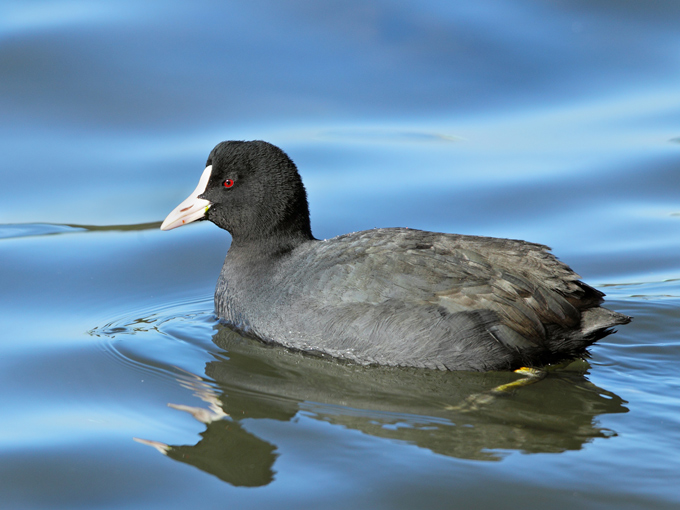

Pohang-Guryongpo, December 20
A day spent “gulling” under largely clear skies with the westerly wind increasing from light to moderate and temperatures rising to a mild 7C or 8C before falling sharply again in the evening. Although conditions were poor for finding alcids (and only one Ancient Murrelet was seen, by JL only), species of note included: a neck-banded Whooper Swan on the river in Pohang (too far to read, but white numbering on red); two American and 3+ Asiatic White-winged Scoters; a dozen or more Harlequin Duck; c. 50 loons (mostly Red-throated with at least one Arctic); 500+ Great Crested Grebe; one White-tailed Eagle (in Pohang); and probably 10+ Light-vented Bulbul. Our main focus throughout the day, however, was on gulls, and at least 11 species were found along with one Caspian-type gull, a couple of dark First Calendar-years that suggested smithsonianus, and several really puzzling individuals (two of which are included here).
Gulls seen during the day, in most cases not counted but estimated, included:
- Black-legged Kittiwake Rissa tridactyla. At least 250 were seen in one scan, and likely many more were missed, mixed in with a huge feeding flock of Black-headed Gulls.
- Black-headed Gull Chroicocephalus ridibundus. Easily the most numerous bird of the day, with a huge flock feeding off from Daebo and several roosts of between 3,000 and 5,000 strung along the eastern side of the peninsula. Although only a few quick, coarse counts were made probably ~25,000 were seen in total. Personally (for both NM and JL), this is easily the highest number of Black-headed Gull seen at any site in the ROK and most likely anywhere. For greater context, this estimate is three times higher than any count given in Park Jin-Young’s 2002 thesis (8,000 in January 2001, along perhaps the same part of the coast); and is about the same as the total number counted nationwide in the MOE winter census in 2007, 2010 and 2013.
- Saunders’s Gull Chroicocephalus saundersi. Two or three were in the river in Pohang.
- Black-tailed Gull Larus crassirostris. Probably c. 500 were seen during the day, including a few still in largely juvenile plumage.
- Common Gull Larus canus. Probably 100-150 were seen during the day.
- Glaucous-winged Gull Larus glaucescens. One adult and three First Calendar-years. None of the First Calendar-years were as dark as the one seen in Gangneung on December 6th.
- Glaucous Gull Larus hyperboreus. Seven or eight adults were seen along the west coast of the peninsula; none were seen along the east coast; and puzzlingly no First-winters were seen during the day.
- Vega Gull Larus vegae. At least 800, showing the predictably huge range of characters “typical” of this gull, with dark and pale First-winters; huge and much smaller-looking adults; and adults with cloudy-grey tones to the upperpart grey, and a few which looked much darker. No birulai types were noted, however.
- Mongolian Gull Larus mongolicus. Probably three white-headed adults and ten or so First-winters were seen during the day (showing a great range in size, but with the First-winters sharing the same pale-grey scapulars and mantle, with darker anchors or bars; worn tertials; and white-looking head, some with a trace of streaking still on the crown, others much cleaner-looking already).
- Slaty-backed Gull Larus schistisagus. Probably 300-400 were seen during the day, with non-adults displaying a great range in plumage.
- Taimyr Gull Larus heuglini taimyrensis. Small numbers were present in all of the main gull roosts, especially those close to Guryongpo town, and probably 30-40 were seen during the day. Of note, several adults were still in active primary moult (already completed in the vast majority of vegae), while several First-winters were instead rather well-advanced, with much white coming through on the head and strongly-scaled upperparts.
- Caspian-type Gull Larus cahninnans / mongolicus / barabensis. One (gorgeous) adult was watched well in excellent light. The identification of birds like this is massively complicated by a poor understanding of the appearance of eastern Caspian Gull; probable hybridization in the east of the range of cachinnans (where it is believed that it might meet barabensis and might also meet mongolicus etc.); and confusion with one or more populations of mongolicus. Identification as cachinnans, barabensis or mongolicus is strongly suggested in mid-winter by its gleaming white head and limited streaking, confined to light streaks on the nape. The bird appeared to be a little smaller than adjacent Vegas, suggesting it was perhaps a female. Separation from mongolicus was suggested by the upperpart grey tone (slightly paler than Vega: many mongolicus are slightly and some rather darker); odd, narrow “pear-shaped” head; longish-looking bill (especially if a female) with narrow elongated slit; puffed-full chest; thinnish-looking legs; and very long primary projection. The bill was also rather brightly coloured for a non-breeding mongolicus, and showed less black than might be expected, with a more obvious red gape line, while the legs were on the pale side. Separation from barabensis was based on its too-pale upperpart grey tones; the lack of contrast on the underwing between the wing coverts and the flight feathers; and bare part coloration. Problems with identification as a cachinnans appear to include the colour of the oribital ring (clearly red, not orange as indicated by Malling Olsen’s book: though multiple images of Caspian Gull from the east of the range in Azerbaijan have similarly-coloured orbitals: see http://chrisgibbins-gullsbirds.blogspot.kr/2012/08/adult-eastern-caspian-gulls-from.html ); the paleness of the eye, with limited darker speckling (though this too is shown by some); the suspected pattern on some of the primaries, including the amount of black on what is visible of P10 (even though eastern Caspian are often said to show less white and more black than western birds); and perhaps, most importantly, bill length and fullness of the head and rear of the crown combined with its lack of a long-necked look during the observation: all less extreme-looking than many cachinnans within their known breeding range. This bird therefore fell in between what might be expected of mongolicus, cachinnans and barabensis.
- Dark First Calendar-year. A strikingly attractive “hot chocolate-colored” gull, with a Lesser Black-backed type face mask and long-looking primary projection. More or less in juvenile plumage, it had a heavily barred skua-like uppertail coverts and rump (with five or six complete bars, fading out across a white-based central rump) and also an apparently all dark-tail (just with faint markings towards the base of the outer tail feathers), both features suggesting a North American origin, as not typical of e.g. vegae or taimyrensis. However, the bird looked quite attenuated, and the bill was too solidly dark and the head too washed with brown for what might be expected of smithsonianus. And how to interpret several blackish centres to some of the upper scapulars? Comments, as always, are welcome.
- Vega-type. An especially slim-billed bird which showed unusually extensive soft-grey on the upperparts for First-winter Vega. Comments, as always, are welcome.
 Vega type, © Nial Moores
Vega type, © Nial Moores Vega type, © Nial Moores
Vega type, © Nial Moores
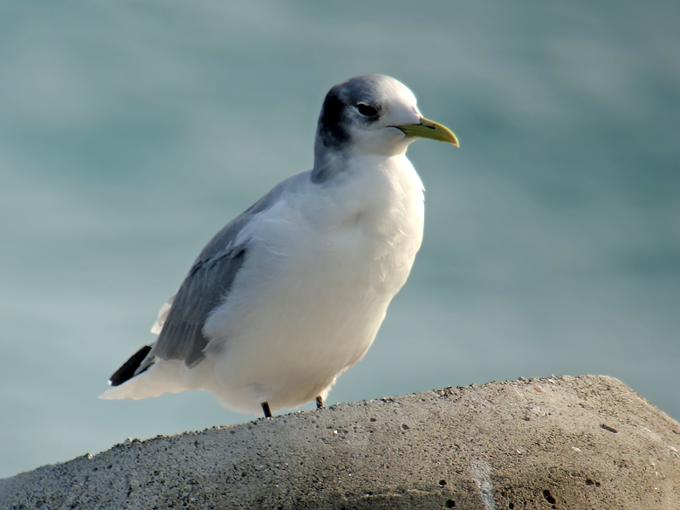

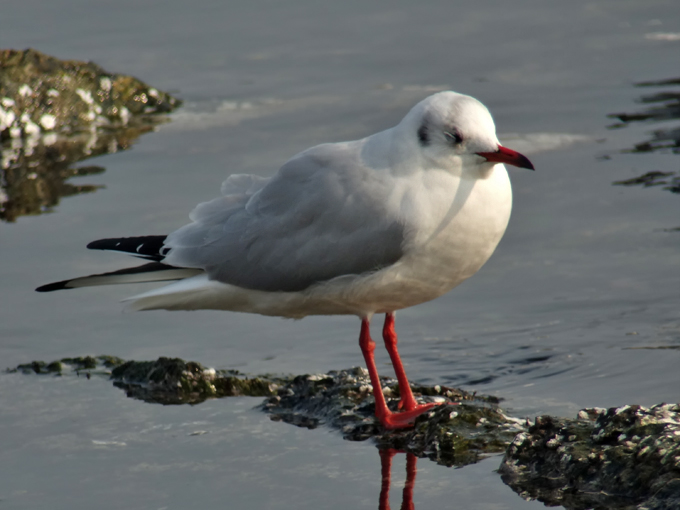

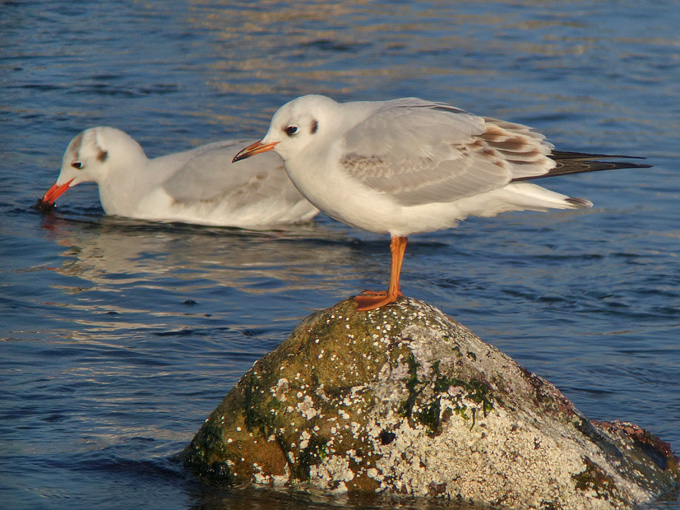
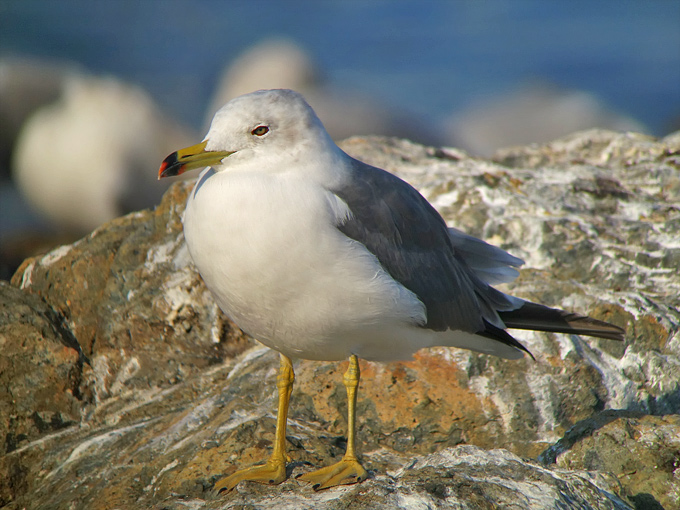
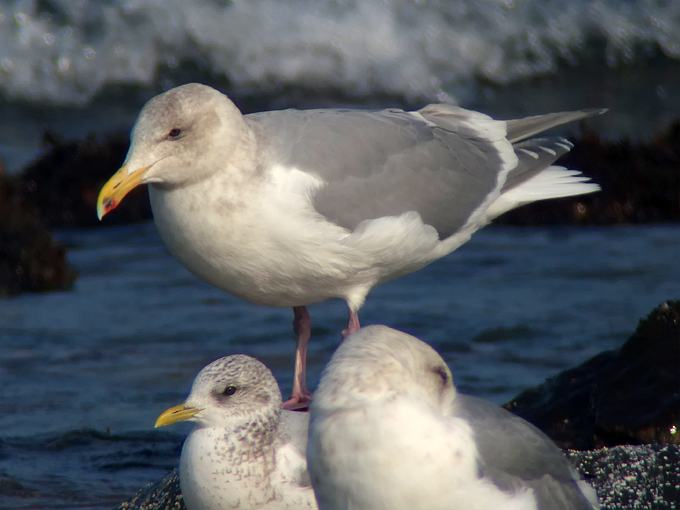



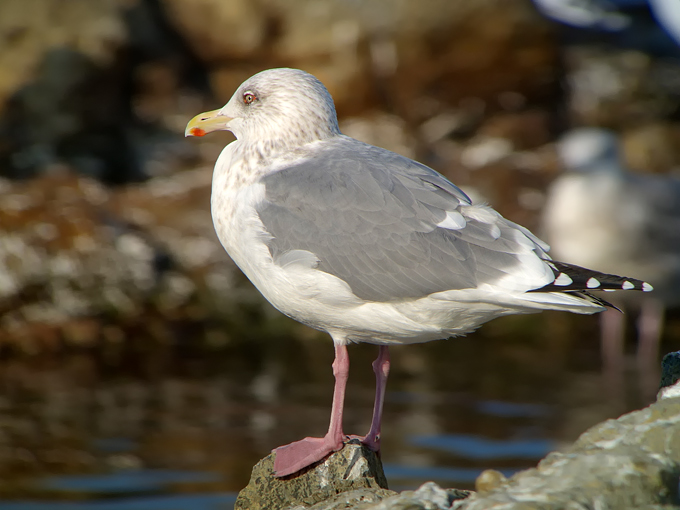
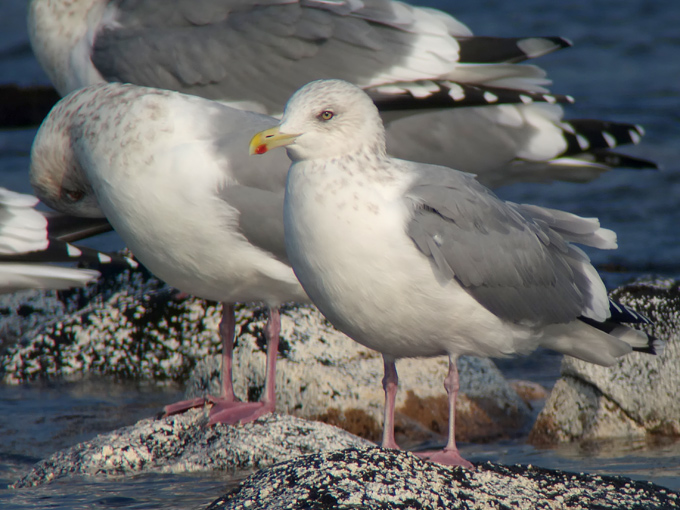












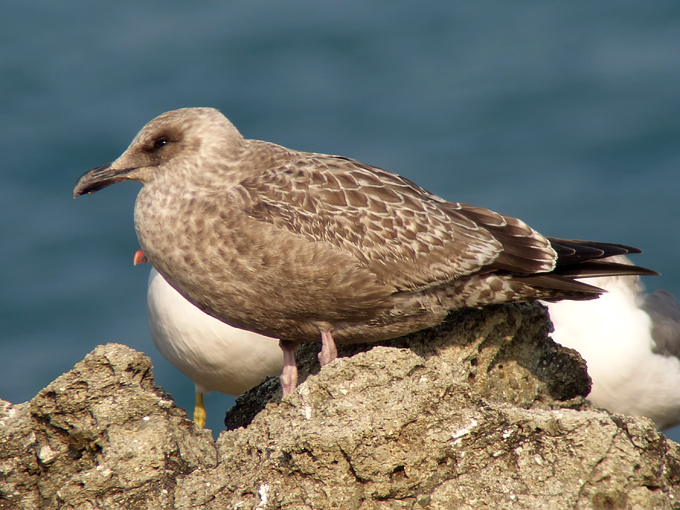

Nakdong River, December 19
I had a couple of hours this evening so I went quickly to one of the nearby parks at the Nakdong to get some birding in before sunset. This week has been cold, even in this southeastern region. Today was somewhat of an exception. There was almost no wind and the river was as smooth as glass. There were Whooper Swans, Tufted Ducks and many distant gulls on the river. A few groups of Bean and White-fronted Geese were seen in flight as well as small group of Rook. Much of the riverside wetland area has been closed off for the winter months in order to protect the wintering bird species. At some of the exposed reed areas I was able to find several Penduline Tit (mostly heard), saw a few Pallas's Reed Bunting and some Buff-bellied Pipit in flight. Most interesting record of the evening was a Water Pipit feeding on one of the frozen ponds, which was a personal first. I've only heard about one other record in the southeast, which was at Junam Reservoir in November of 2004.
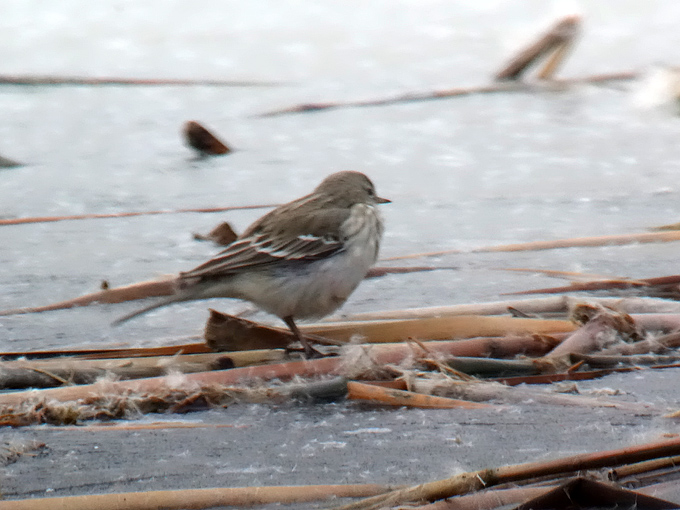


Igidae, East Busan, December 12 and 16
In cool conditions on the 12th (2-3C at dawn rising to 7C during the day) and rather colder conditions on the 16th (3-4C all day, with a strengthening westerly wind and occasional snow-spit ahead of the next plunge of colder air), a mix of seawatching and walking the trails found a very decent mix of winter birds.
Over the sea most interesting on the 12th were loons, with 235 counted heading south between 10:05 and 11:20. All were small or medium-sized but too distant to be identified to species. Other species of note moving south over the sea included four Common Merganser, two Common Pochard and ten Ancient Murrelet. In addition, one group of 60 southward-bound Black-headed Gull found themselves under attack by a pair of Peregrine Falcon, and lost a First-winter in the process; and 31 Rook also came back-in-off, from the direction of Teima Do / Japan.
On the 16th, only 15 loons were counted moving south in 90 minutes, but these included two confirmed Red-throated Loon and one presumed Yellow-billed Loon (very distant, but obviously massive). Further seawatching highlights included two close-in Ancient Murrelet, and best of all one Long-billed Murrelet, which showed well in flight and then for a few seconds on the sea. This is at least my second record here. In addition, seven Black-necked Grebe, three (Asiatic) White-winged Scoter, three Common Shelduck (my first here) and a Glaucous Gull went south, along with several hundred Vega and Common Gulls and a dozen or so Slaty-backed Gull and Black-legged Kittiwake.
On the land, most numerous species both days was Vinous-throated Parrotbill, with several large packs of 100-300 birds rattling the undergrowth, and numbers in the park probably now close to 1,000 (presumably made up of both resident birds and those from adjacent areas?). Also present in high numbers were Eastern Great Tit (probably 150 or so on the 12th but only c. 50 on the 16th, including two quite bright-mantled birds), Yellow-throated Bunting (perhaps 50-100 on both dates) and Brambling (probably c.100), with lesser numbers of expected species including Brown-eared Bulbul (30-50), Goldcrest (20-30), Japanese White-eye (20), the four woodpeckers (Japanese Pygmy, White-backed, Great Spotted and Grey-headed), the other tits, and-half-a-dozen Bull-headed Shrike. Notable in their absence were Grey and Tristram’s Bunting, Yellow-bellied Tit and Light-vented Bulbul. Species of note included a couple of Red-flanked Bluetail, 2-3 Japanese Bush Warbler, 3-5 Siberian Accentor (on both dates), probably 8+ Eurasian Bullfinch on the 12th (but only one on the 16th), a sea-eagle heard only (probably a White-tailed Eagle), as it went off low over the trees on the 16th. More remarkable was a single Chinese Blackbird heard and three Common Rosefinch seen (including one red male) on the 12th. Both are very scarce in the southeast of the country, and although both overwinter very occasionally, these are perhaps the first mid-winter records of either species from this part of the country (?).

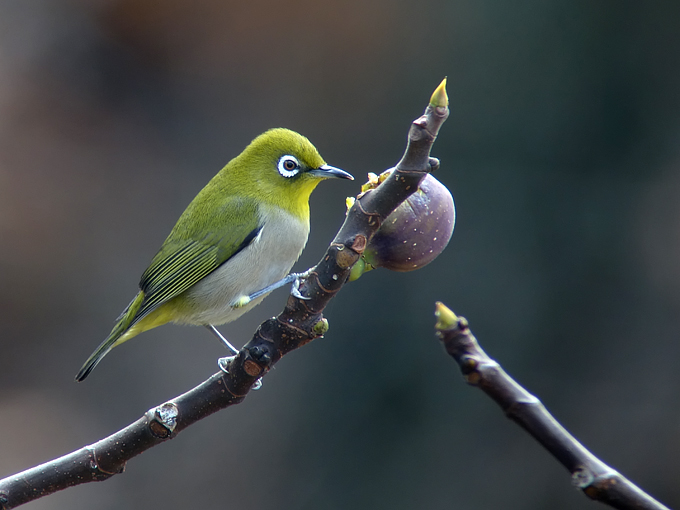



Cheolwon, December 14 - 15
I spent a privileged few hours on the afternoon of the 14th and the morning of the 15th driving (being driven, actually) around the restricted area by Pastor Jung and Mr. Shin of the Border Peace School and YMCA, respectively—much thanks for their help and hospitality! Crane numbers were decent—we saw conservatively over 400 White-naped Cranes and c. 250 Red-crowned Cranes (allowing for possible double-counting; birds were moving about a good deal). However, we did not perhaps come across the mythical “main flock”—largest groups were about 80 White-napes on the reservoir and the fantastic sight of about 60 cranes, the majority Red-crowns, in a single field. No other crane species noted, but we did see several Cinereous Vultures, a Eurasian Sparrowhawk, several Kestrels, scattered White-fronted Geese and 1 Chinese Grey Shrike. At the Peace School’s lodge: about 8 Long-tailed Rosefinches, a few Rustic and Yellow-throated Buntings, and a Daurian Redstart.



Hwapo Cheon, December 13
Had a really wonderful day with several students (up to 200!) from many of the different schools (elementary, middle, and high) of the Gimhae school district. This event was organized by the Gyeongsannamdo UNESCO Associated Schools Chapter. We first visited the hometown of the late President Roh Mu-hyeon. Then we made a stop at Hwapo Cheon where students were able to experience and learn more about one of our local wetlands for wintering waterbirds. Finally, we finished at a local shopping outlet to campaign and raise awareness for better education, facilities, and clean water for some of our world's regions of need.
At Hwapo Cheon, our time was limited but students made teams and were given tasks to achieve around the wetland. It was very cold but still the students were enthusiastic. Students were remarkably quiet completing tasks, as one of their objectives was to minimize the impact of disturbance. Birds observed at the event included Dusky Thrush, Daurian Redstart, several Mallard, a few flocks of Taiga Bean Geese in flight, Rook, Korean Magpie, Large-billed Crow and 200+ Cinereous Vulture. We were all really impressed with this last species. We were able to view them in close proximity in flight and on the rice fields because someone was feeding them nearby.


Paju, December 13
Following a great map from Ha Jung Moon, I found a Long-eared Owl (after some searching) .... close to the trunk (and hence easy to miss). Other species seen in a few hours of afternoon birding included 3 Common Kestrels, 1 Naumann's Thrush, 2 Cinerous Vultures, about a dozen Long-tailed Tits, about 100 Common Mergansers, several flocks of Greater White-fronted Geese and 2 Ruddy Shelducks amongst others.
National Arboretum, December 12
A quiet day at the Sumeokwan. When I arrived at opening time, it seemed I had the snow-dusted place to myself: blissful, but hardly any birds! A Dipper greeted me at the bridge, but no snipes in sight there or at the stream sections I was able to survey. The only winter finches were 5 or 6 Bramblings; I later thought I heard a distant Bullfinch but that may have been wishful thinking. The following birds showed or sounded in small numbers: Great, Marsh, and Long-tailed Tits; Eurasian Nuthatch, Daurian Redstart, a few Dusky/Naumann’s Thrushes, Rustic and Yellow-throated Buntings, Japanese Pygmy, Great Spotted and White-backed Woodpeckers, a pair of Eastern Buzzards, a flyover flock of 8 Mandarin Ducks. Highlights were a pair of noisy Black Woodpeckers and a single sapling decorated with 6 Varied Tits.
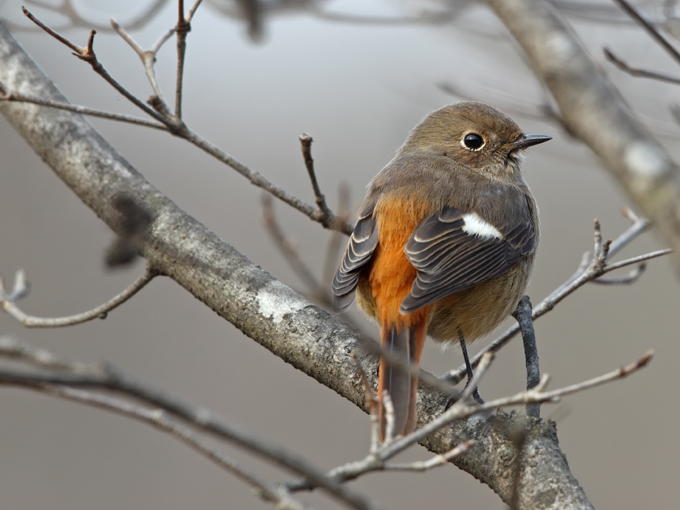




Junam Reservoir, December 9
Although the winters here can be cold and grey and at times dreary, some winter days are absolutely gorgeous. Today was one of those days. I had only a few hours in the afternoon so I decided to visit the Junam Reservoir (especially after hearing about reports in the north of the country of a of a Demoiselle Crane and Black-shouldered Kite). At Junam, the main reservoir, the water seems to remain at a high water level. There were mostly Whooper Swan, Taiga Bean Geese, Mallard, a few Northern Pintail and a few Common Pochard among many of the usual wintering ducks. On the rice fields there were hundreds of geese opposite the main lake, including Greater White-fronted and Taiga Bean. I found a small group of about 38 White-naped Crane in a flock on the rice fields accompanied by two Hooded Crane. They were a stunning site. Far Eastern Skylark and Buff-bellied Pipits could be found on the fields and at one exciting moment a Merlin dropped by in hot pursuit of some Oriental Turtle Doves. Still, the most impressive sights of the afternoon were that of a Hen Harrier in flight over the rice fields and then an Amur Leopard Cat observed catching the night's dinner, a mouse. The day was finished with a beautiful sunset as a few of the White-naped Cranes taking roost on the rice fields near the many hundreds of feeding geese.
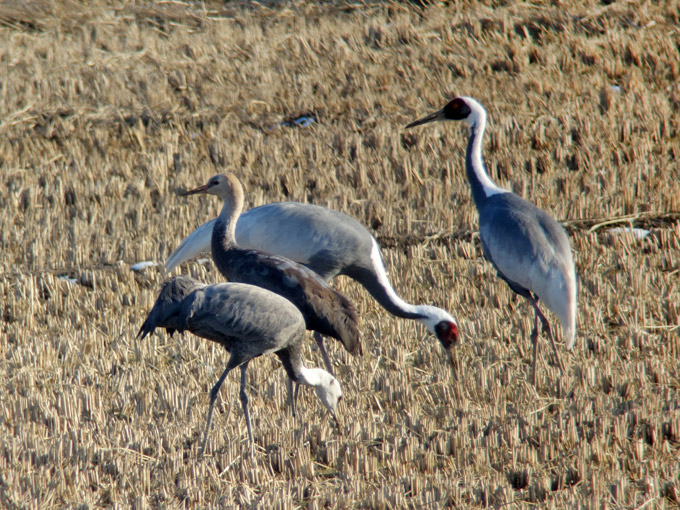
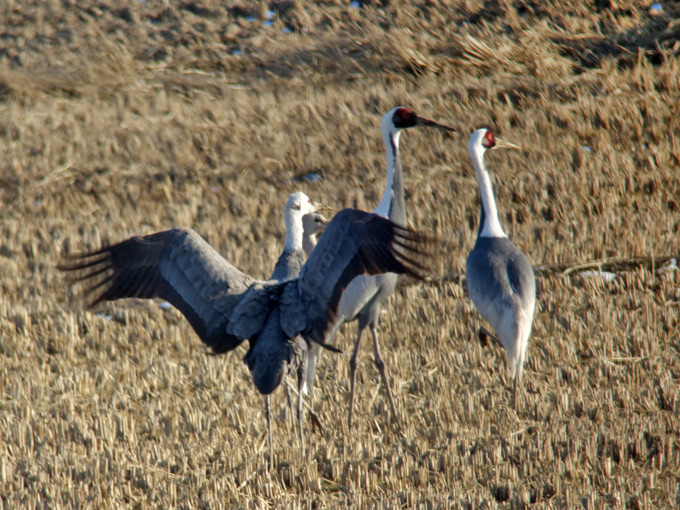
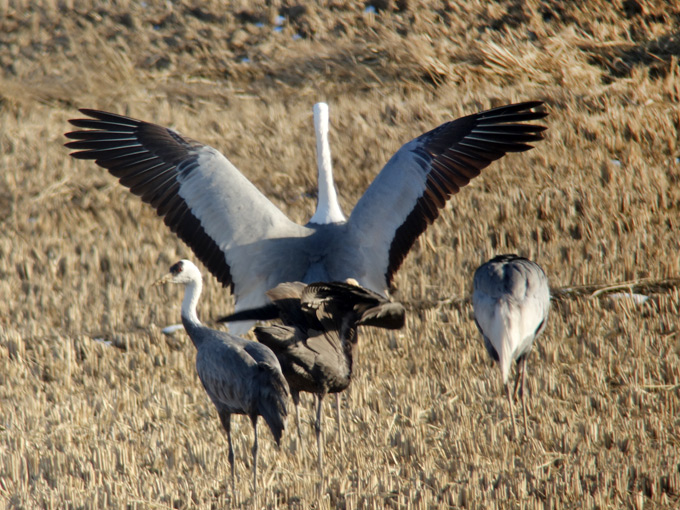
Yeongsan lake barrage, December 9
A big flock of birds on the water made me stop at the barrage. It turned out to be an interesting mix of birds: small numbers of Mallard and Gadwal, 19 Common Pochard, 3 Tufted Duck, c. 50 Common Merganser, c. 100 Great Crested Grebe, c. 20 Eurasian Coot, a few Grey Heron, 3 Black-headed Gull and one Mongolian Gull. Close to the parking place in the scrub a Bull-headed Shrike.


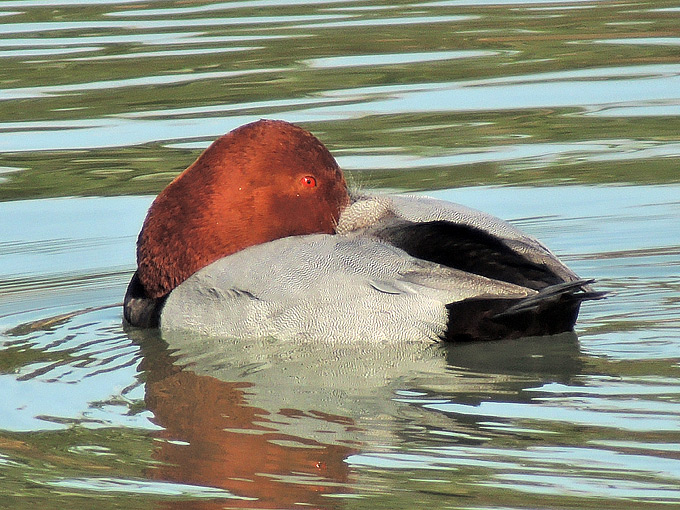






Taebaek Mountain, Gangwon Province, December 7
Last winter Mr. Shim Heon-seop found a large flock of Asian Rosy Finch on Taebaek Mountain. He kindly shared information of his spectacular find and of the location, which is an area with wind-turbines and open agricultural fields at about 1200masl. Park Jin Young’s doctoral thesis also contains a record of this poorly-known species in the Taebaek City area: 300 seen in January 1998, published by Lee Jin-Won (likely the highest count to date nationally). We therefore decided to take advantage of the cold but dry conditions to visit the area in case the species might prove to be somewhat regular there.

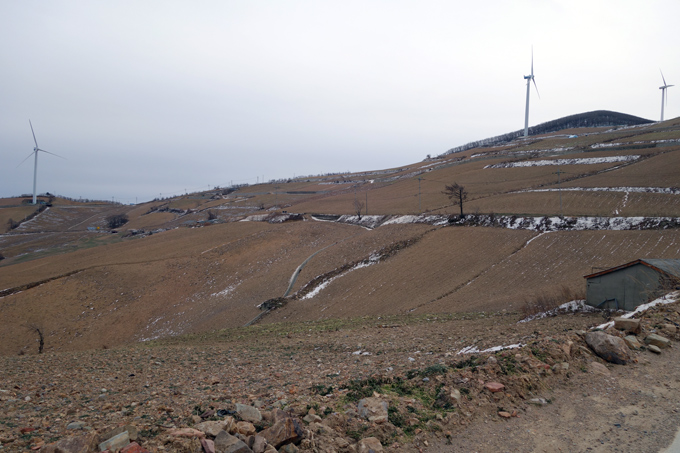
Soon after arrival, we found a large flock. The Asian Rosy Finches were, as in most areas, highly mobile and difficult to approach, even though once or twice they landed briefly only a few meters away. The flock (or flocks: see below) made wide circuits over the hill-side, before dropping into a small clump of trees and then onto the ground, before lifting up once more, most often in response to a passing raptor or vehicle. On his excellent Birding Beijing website, Terry Townsend eloquently described this typical restlessness of Asian Rosy Finch flocks, landing and lifting off soon after, “as if the ground was too cold for their feet!” (see: http://birdingbeijing.com/2014/11/07/return-to-lingshan/).
NM made a series of coarse quick counts of the flock (in blocks of ten) during the 90 minutes or so we were there, which ranged from a conservative 310 to a maximum of 375. A series of images taken of the main flock in flight contained 337 birds in one image and, 30 minutes later 355-359 in the second (please check the image yourself and let us know how many you can see!). Both JL and NM also saw a sub-group of c. 50 birds join the main flock just before we left: it seems very likely, however, that these were included in this flock 355+.

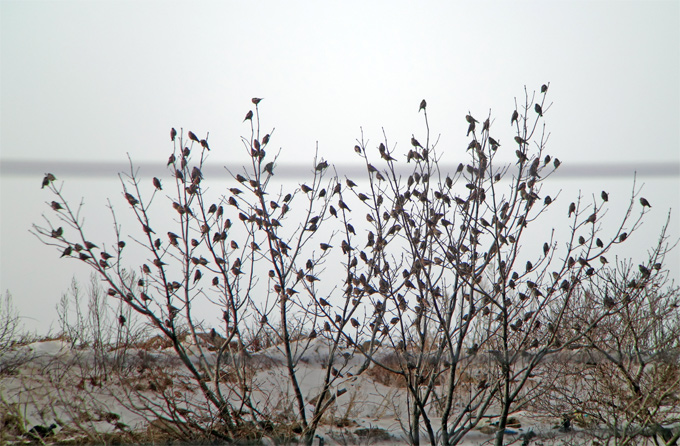
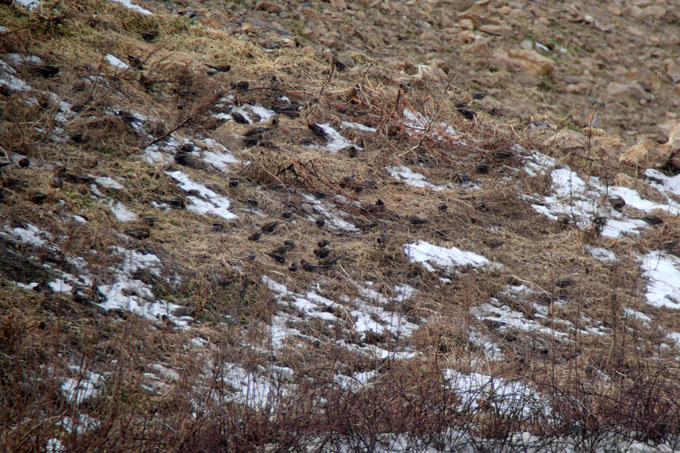
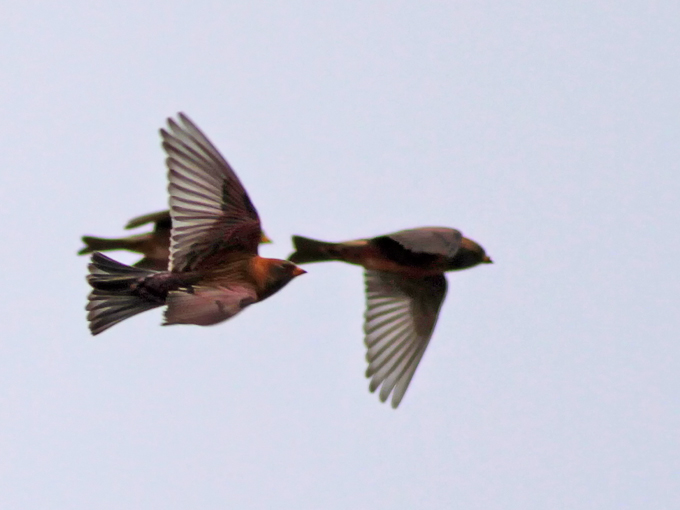
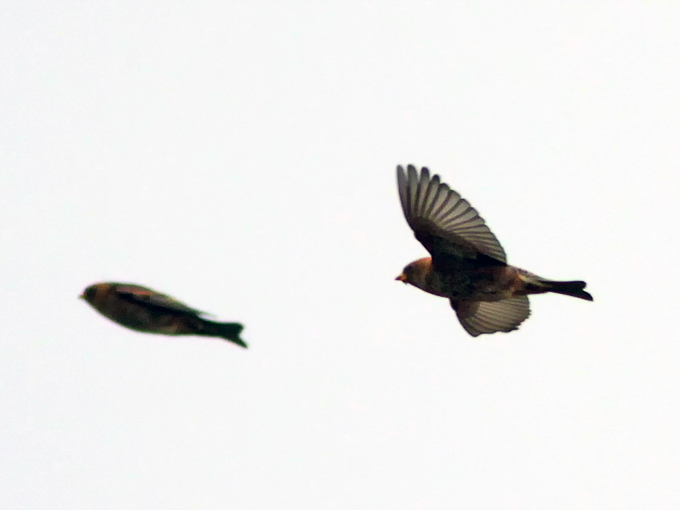
The Birds Korea 2014 Checklist lists Asian Rosy Finch as WV1. While this assessment appears to be technically correct (i.e. there are still <10 records annually), it is very likely that the small number of records is largely a result of the very few birders visiting potentially suitable habitat in winter. Since the 2009 / 2010 winter, large flocks of Asian Rosy Finch have been found on Jeju (180, in November 2010) and Jiri Mountain (150?) as well as on Taebaek; and smaller flocks have been found at several sites, including on the coast in Goseong County, inland in Busan and on Deokyu Mountain in Jeonbuk. Records of this species therefore come from many parts of the country. As 70% of the nation is mountainous, and many peaks and cliff-faces are extremely difficult to access in winter, it seems highly probable that Asian Rosy Finch is much more regular and locally numerous in the ROK than presently understood. As such, the status code of Asian Rosy Finch will be amended in the next Checklist update. To date, there appears to be no evidence to suggest a recent rapid increase in the species here or in the wider region.
Also present in the same area as the Asian Rosy Finch flock, were 3 Cinereous Vulture, probably two Eastern Buzzard, and single Eurasian Sparrowhawk, Eurasian Kestrel, Large-billed Crow, Siberian Accentor and Pallas’s Rosefinch.
Lower down the mountain in 10-15 minutes of rapid assessment in birch forest and earlier in mixed forest and stream edge, further species of note included 5-8 Siberian Accentor, c.4 Eurasian Bullfinch and a single Long-tailed Rosefinch.
Please note: the access road to this site is narrow, steep and potentially impassable in snow or wet conditions.
Hwaseong, December 7
Birding News from Robin Newlin and Im Kwang Wan
A relatively quiet morning only in limited parts of Hwaseong: highlights were several Eurasian Coots, Little Grebes, Shovelers, Falcated Ducks, Mallards, Gadwalls and Eurasian Teal, all (except probably the grebes) put up and chased without success by a Northern Goshawk; single Far Eastern and Upland Buzzards, 2 Hen Harriers, several Common Kestrels, a Eurasian Sparrowhawk, a Peregrine Falcon, scattered grazing flocks of Bean and White-fronted Geese, a single Buff-bellied Pipit, one heard Common Reed Bunting and several heard Far-Eastern Skylarks.
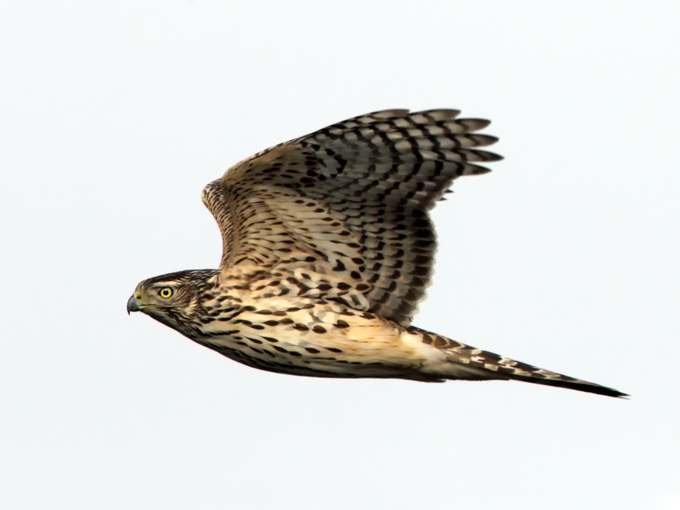

Haenam and Area, December 7
A group of nine joined the Gwangju branch of Birds Korea on an outing to Haenam county. The weather was fairly cold, but scattered clouds and sun made for excellent viewing at three bodies of water in southern Jeollanam-do. A total of 62 species were observed throughout the day. Highlights are below.
- 5 Northern Lapwing in the agricultural fields near Gangjin Bay
- 55+ White-cheeked Starlings at Gangjin Bay
- 2 Brown-cheeked Rails heard calling in a drainage ditch at Gangjin; one was briefly seen by PB only, though everyone heard the two birds calling. A link to a short recording is available.
- c. 400 Whooper Swans at Gangjin Bay
- moderate numbers of waterfowl at Gocheonnamho Lake, though geese numbers were down dramatically from previous visits. Waterfowl observed included: Greater White-fronted Goose (c.2,500-3,000), Tundra (250) and Taiga Bean-goose(1), Common Merganser(10+), Red-breasted Merganser (5+), Smew (1), Gadwall, Common Goldeneye(10), Eurasian Wigeon, Falcated Duck (5) and Common Pochard
- variety of raptors around Gocheonnamho, including Eastern Buzzard (4) and singles of Peregrine Falcon, Common Kestrel, and Merlin
- 3 Dusky Thrush at Gocheonnamho Lake
- enormous flock of Baikal Teal at Geumho Lake; c. 200-250,000 individuals
- flyover of c. 35 Lapland Longspurs at Geumhoho Lake
- a single Short-eared Owl hunting over the reeds around Geumhoho Lake just after sunset

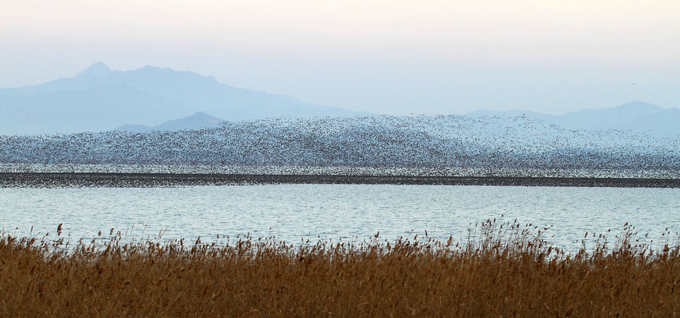
Cheolwon, December 5
A short trip to frigid Cheolwon: my first stay at the comfortable Durumi (Crane) Pension near the Togyo Reservoir.
On the Hantang River from a crane-watching hide: an attractive visa of ice-crusted river, reeds, mountains, rising full moon, Red-crowned and White-naped Cranes, Common Mergansers, Azure-winged Magpies, Vinous-throated Parrotbills and Meadow and Yellow-throated Buntings. Also in the area: a Bull-headed Shrike, a (heard) Long-tailed Rosefinch, some (also only heard) Long-tailed Tits, a Far Eastern Buzzard, several Cinereous Vultures, thousands of White-fronted Geese, a few Whooper Swans, and a few calling Daurian Redstarts and Far-Eastern Skylarks.
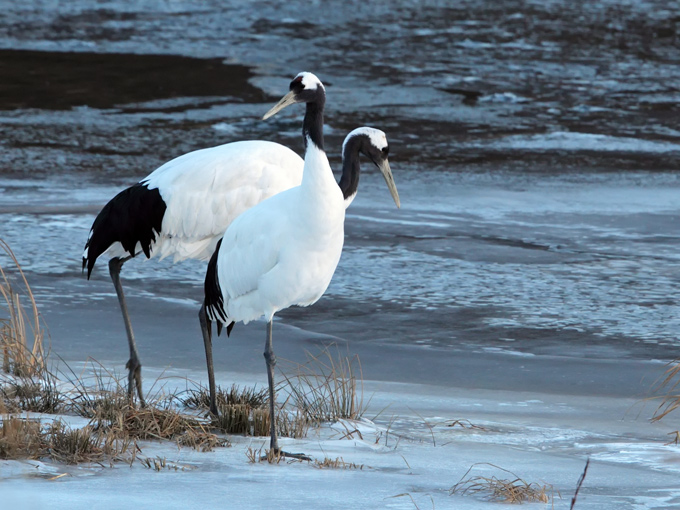
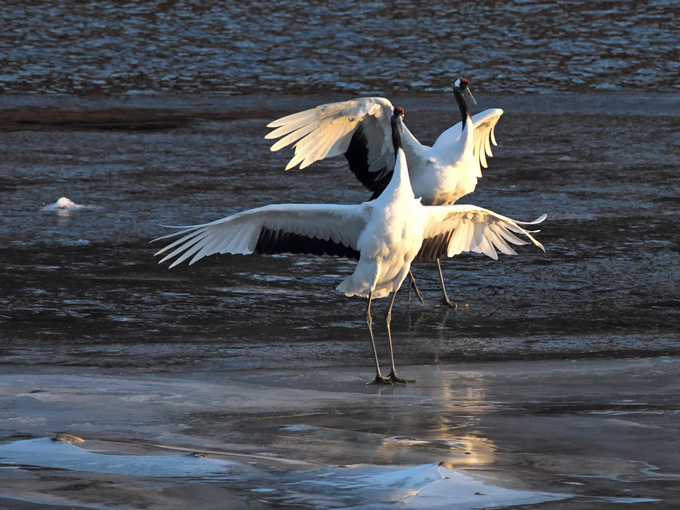

Usop swamp, December 4
Also later the day when visiting the Usop swamp the weather kept cold with heavy snow showers and sunny breaks. The open water of swamp is largely covered with the remains of lotus plants which many ducks used to hide. The walk all around the swamp revealed c. 60 Whooper Swan, c. 200 Taiga Bean Goose, c. 500 Mallard, c. 200 Eastern Spot-billed Duck, c. 200 Eurasian Teal, several Eurasian Coot, one Grey Heron, one Common Kestrel, plenty of Brown-eared Bulbul and Oriental Turtle Dove, one Bull-headed Shrike, one Olive-backed Pipit and several Rustic Bunting.


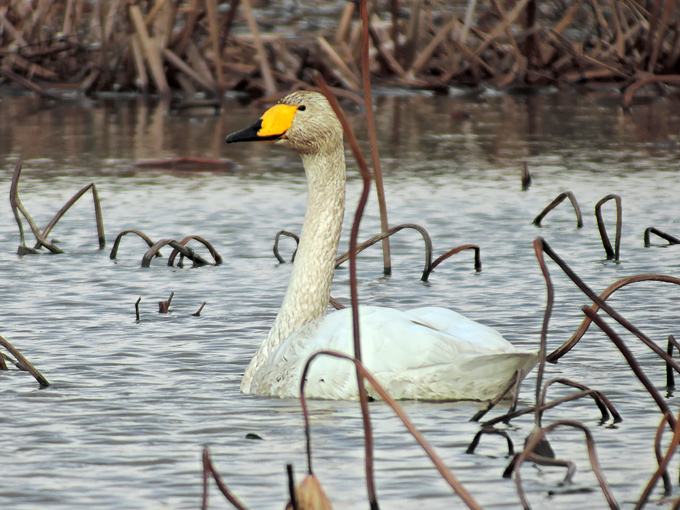


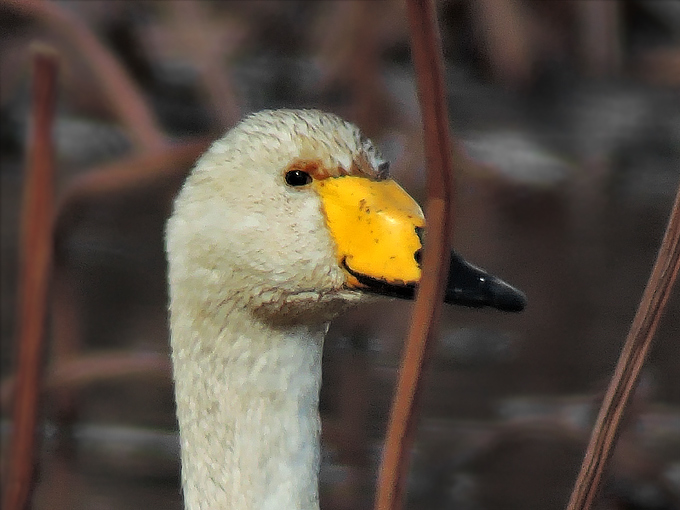
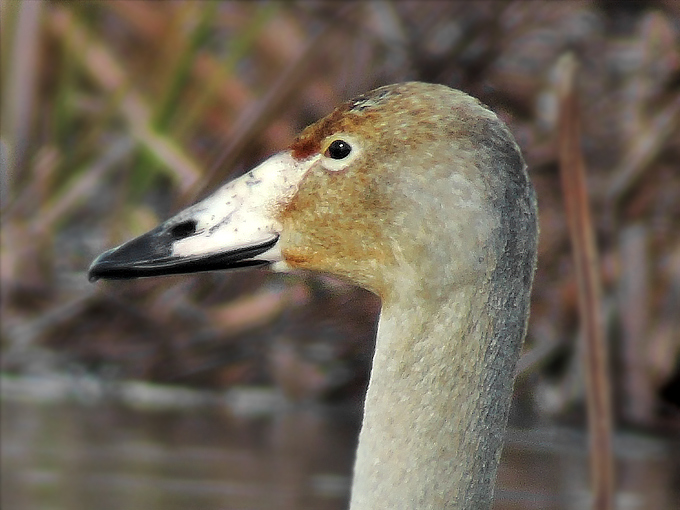
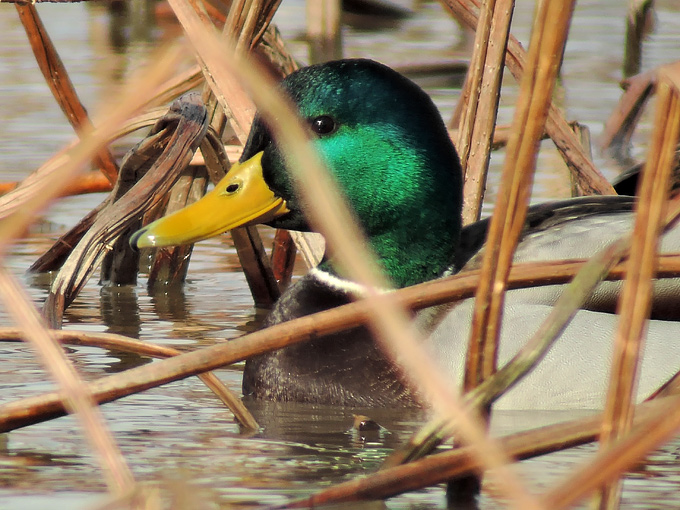

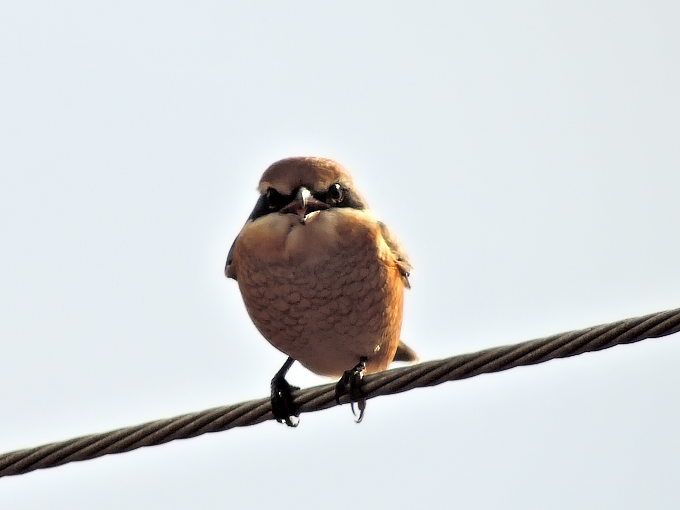
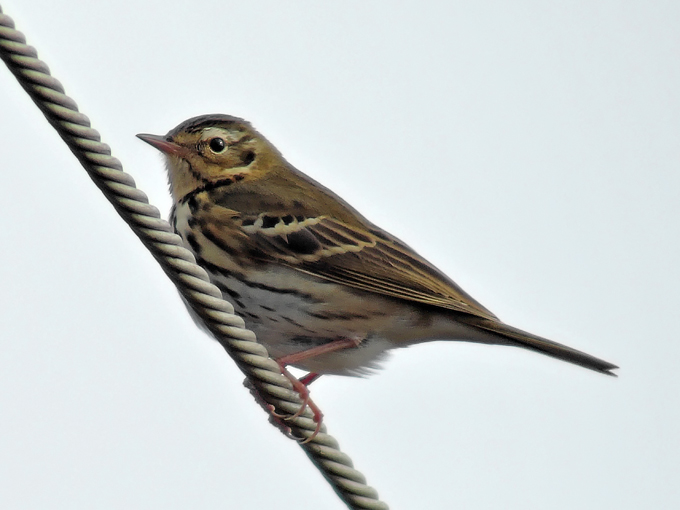
Jeollanamdo, December 4
The visit to the river at sunrise had much more birds observed than the week before. Unfortunately most of the time the weather was not very welcoming: showers with rain and snow changed rapidly with short sunny periods. This morning many ducks on the water: 23 Gadwall, c. 60 Spot-billed Duck, 30-40 Mallard, at least 70 Common Teal, 17 Common Merganser and 4 male and 7 female Scaly-sided Merganser. Also seen were 4 Grey Heron,, 3 Great Egret, one Eurasian Coot, one Eastern Buzzard one Common Kingfisher, a flock of c. 30 Oriental Turtle Dove, plenty of Eurasian Magpie, a few Azure-winged Magpie, two Bull-headed Shrike, a very noisy flock of c. 20 Vinous-throated Parrotbill, one Daurian Redstart and two small groups of Bunting; 5 Rustic Bunting and 3 Yellow-throated Bunting.




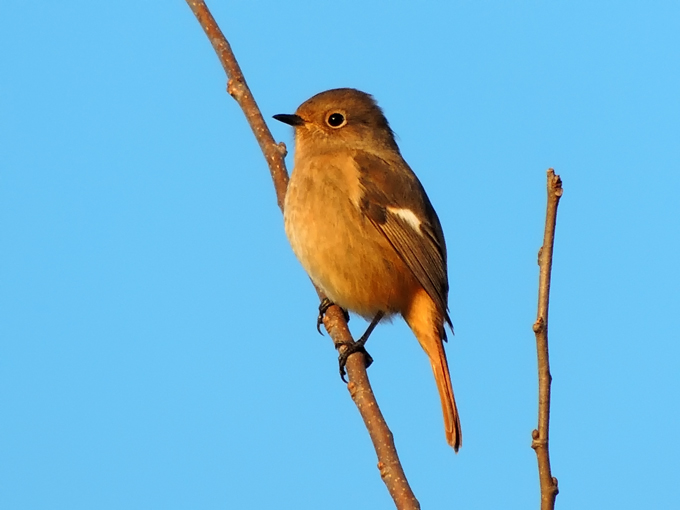

Gimhae, December 3
Took a nice afternoon walk at Sineosan. Not many species but was very pleased to hear and see a few Siberian Accentor. Haven't heard any reports of Alpine Accentors yet this season but definitely on the look out for them. Highlight of the walk were three Eurasian Bullfinch, including one stunning rosacea.





